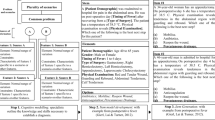Abstract
Automatic item generation is a rapidly evolving research area where cognitive theories, computer technologies, and psychometric practices are used to create models that produce test items with the aid of computer technology. The purpose of our study is to describe the workflow in a strategic partnership between researchers as the University of Alberta and content specialists at the testing company ACT Inc. In this workflow, technical automated item and content generation expertise was combined with item development and subject-matter expertise for the purpose of producing large numbers of high-quality, content-specific test items. The methods and processes described in our study will also be used to help transform item and passage development at ACT Inc. from what is currently a manual, labor intensive, non-scalable process to a specification driven, automated, highly scalable process.
Access this chapter
Tax calculation will be finalised at checkout
Purchases are for personal use only
Similar content being viewed by others
Notes
- 1.
To date, Drs. Gierl and Lai have received over $5.5 million in external grants for their AIG research program. They have published 1 book, 12 book chapters, and 19 refereed articles as well as delivered 29 invited presentations and 53 conference presentations on the topic of AIG. Drs. Gierl and Lai received the National Council on Measurement in Education Annual Award in recognition of their AIG research program in 2016.
References
F. Drasgow, Technology and Testing: Improving Educational and Psychological Measurement (Routledge, New York, 2016)
F. Drasgow, R.M. Luecht, R. Bennett, Technology and Testing, in Educational Measurement, 4th edn. ed. by R.L. Brennan (American Council on Education, Washington, DC, 2006), pp. 471–516
R.M. Luecht, Computer-Based Test Delivery Models, Data, and Operational Implementation Issues, in Technology and Testing: Improving Educational and Psychological Measurement, ed. by F. Drasgow (Routledge, New York, 2016), pp. 179–205
S. Sireci, A. Zenisky, Computerized Innovative Item Formats: Achievement and Credentialing, in Handbook of Test Development, 2nd edn. (Routledge, New York, 2016), pp. 313–334
S. Lane, M. Raymond, R. Haladyna, S. Downing, Test Development Process, in Handbook of Test Development, 2nd edn. ed. by S. Lane, M. Raymond, T. Haladyna (Routledge, New York, 2016), pp. 3–18
M.J. Gierl, T. Haladyna, Automatic Item Generation: Theory and Practice (Routledge, New York, 2013)
R.M. Luecht, Automatic Item Generation for Computerized Adaptive Testing, in Automatic Item Generation: Theory and Practice, ed. by M. Gierl, T. Haladyna (Routledge, New York, 2013), pp. 196–216
L. Rudner, Implementing the Graduate Management Admission Test Computerized Adaptive Test, in Elements of Adaptive Testing, ed. by W. van der Linden, C. Glas (Springer, New York, 2010), pp. 151–165
K. Breithaupt, A. Ariel, D. Hare, Assembling an Inventory of Multistage Adaptive Testing Systems, in Elements of Adaptive Testing, ed. by W. van der Linden, C. Glas (Springer, New York, 2010), pp. 247–266
M.J. Gierl, H. Lai, A process for reviewing and evaluating generated test items. Educ. Meas. Issues Pract. 35, 6–20 (2016)
M.J. Gierl, H. Lai, Automatic Item Generation, in Handbook of Test Development, 2nd edn. ed. by S. Lane, M. Raymond, T. Haladyna (Routledge, New York, 2016), pp. 410–429
M.J. Gierl, H. Lai, Using automated processes to generate test items. Educ. Meas. Issues Pract. 32, 36–50 (2013)
M.J. Gierl, H. Lai, S. Turner, Using automatic item generation to create multiple-choice items for assessments in medical education. Med. Educ. 46, 757–765 (2012)
H. Lai, M.J. Gierl, C. Touchie, D. Pugh, A. Boulais, A. DeChamplain, Using automatic item generation to improve the quality of MCQ distractors. Teach. Learn. Med. 28, 166–173 (2016)
M.J. Gierl, H. Lai, Using automated processes to generate test items and their associated solutions and rationales to support formative feedback. IxD&A J. N. 25, 9–20 (2015)
M.J. Gierl, H. Lai, K. Fung, B. Zheng, Using Technology-Enhanced Processes to Generate Items in Multiple Languages, in Technology and Testing: Improving Educational and Psychological Measurement, ed. by F. Drasgow (Routledge, New York, 2016) pp. 109–127
I.I. Bejar, R. Lawless, M.E. Morley, M.E. Wagner, R.E. Bennett, J. Revuelta, A feasibility study of on-the-fly item generation in adaptive testing. J. Technol. Learn. Assess. 2(3), 1–30 (2003)
A. LaDuca, W.I. Staples, B. Templeton, G.B. Holzman, Item modeling procedures for constructing content-equivalent multiple-choice questions. Med. Educ. 20, 53–56 (1986)
M.J. Gierl, J. Zhou, C. Alves, Develo** a taxonomy of item model types to promote assessment engineering. J. Technol. Learn. Assess. 7(2), 1–51 (2008)
C.B. Schmeiser, C.J. Welch, Test Development, in Educational Measurement, 4th edn. ed. by R.L. Brennan (National Council on Measurement in Education and American Council on Education, Westport, CT, 2006), pp. 307–353
M.J. Gierl, H. Lai, J. Hogan, D. Matovinovic, A method for generating test items that are aligned to the Common Core State Standards. J. Appl. Test. Technol. 16, 1–18 (2015)
Author information
Authors and Affiliations
Corresponding author
Editor information
Editors and Affiliations
Rights and permissions
Copyright information
© 2019 Springer Nature Switzerland AG
About this paper
Cite this paper
Gierl, M.J., Matovinovic, D., Lai, H. (2019). Creating Content for Educational Testing Using a Workflow That Supports Automatic Item Generation. In: Reyes-Munoz, A., Zheng, P., Crawford, D., Callaghan, V. (eds) EAI International Conference on Technology, Innovation, Entrepreneurship and Education. TIE 2017. Lecture Notes in Electrical Engineering, vol 532. Springer, Cham. https://doi.org/10.1007/978-3-030-02242-6_3
Download citation
DOI: https://doi.org/10.1007/978-3-030-02242-6_3
Published:
Publisher Name: Springer, Cham
Print ISBN: 978-3-030-02241-9
Online ISBN: 978-3-030-02242-6
eBook Packages: EngineeringEngineering (R0)




